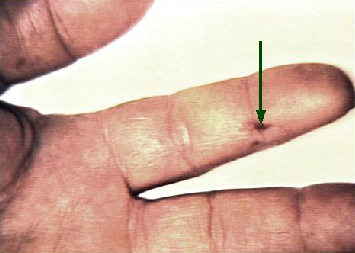Non-Cardiac Manifestations, Subacute vs. Acute
Non-cardiac manifestations of infective endocarditis include cutaneous signs, such as Osler's node, ophthalmologic signs, such as Roth spot, splenomegaly and neurologic findings, such as stroke or cerebritis.
This retinal photograph illustrates a Roth spot. It is a hemorrhage with a white center. These spots often are located near the optic disc. Roth spots may also occur in patients with hematologic disorders. Note also the hemorrhage seen on the left side of the photograph, distiguishable from a Roth spot because it does not have a white center.
This photograph demonstrates a small nodule on the index finger called an Osler's node. Such a lesion is usually transient, tender, purplish and subcutaneous. It may result from either immune complex deposition or a septic embolus.
Endocarditis can be divided into a subacute form, an indolent illness that evolves over several weeks to months; and an acute form, a fulminating disease that evolves over days and has more frequent complications. Patient groups at greatest risk include those with valvular or congenital heart disease, intravenous drug users and the elderly. Endocarditis may develop in patients without a pre-existing cardiac lesion, especially with sustained Staphylococcus aureus bacteremia. The source of infection is often not identified.

